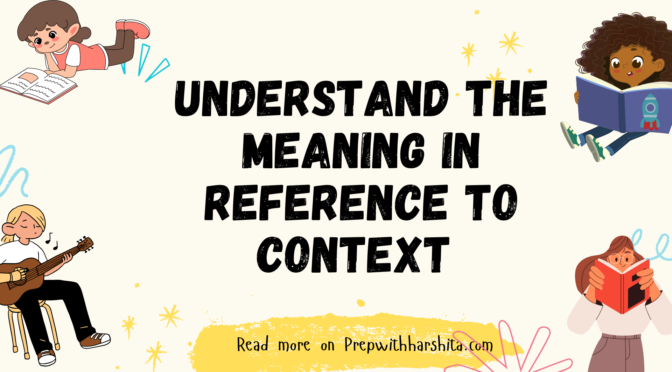Understanding the meaning of words, phrases, or sentences in reference to their context is essential for effective comprehension and interpretation of written or spoken language.
Here’s a detailed explanation of how context helps in understanding meaning:
- Contextual Clues: Context refers to the words, phrases, sentences, or even the broader situation or setting surrounding a particular word or expression. Contextual clues provide hints or cues that help decipher the intended meaning. These clues can include:
a. Surrounding Words: The words preceding or following a particular word can provide clues about its meaning. Words that are synonyms, antonyms, or related in meaning can give insights into the intended sense of the word in question.
b. Sentence Structure: The grammatical structure of a sentence can provide clues about the relationships between words and their intended meanings. For example, subject-verb agreements, verb tenses, or the use of prepositions can influence the interpretation of words.
c. Topic or Theme: The broader topic or theme being discussed can help determine the intended meaning of words or phrases. Understanding the subject matter or the overall context of the conversation or text can guide the interpretation of specific language used. - Semantic and Pragmatic Meaning: Context aids in distinguishing between semantic meaning (the literal definition of a word) and pragmatic meaning (the implied or intended meaning in a specific context). Contextual clues help determine whether a word is being used in its literal sense or has a figurative, metaphorical, or idiomatic meaning.
- Multiple Meanings: Many words have multiple meanings, and the context helps identify which specific meaning is intended. The context narrows down the possibilities and guides the interpretation to the most appropriate meaning based on the situation.
- Cultural and Societal Context: Language is deeply influenced by culture and society. Understanding the cultural or societal context helps interpret idioms, cultural references, or expressions that may not be easily understood without that background knowledge. Cultural context provides insights into the nuances and connotations associated with certain words or phrases.
- Non-verbal Context: In addition to the words themselves, non-verbal cues such as tone of voice, facial expressions, gestures, and body language also contribute to understanding meaning. These non-verbal cues can provide valuable context and help interpret the intended meaning behind the words spoken or written.
- Coherence and Cohesiveness: Context helps in creating a coherent and cohesive understanding of the overall message. By considering the context, the individual words or phrases fit into a larger framework, allowing for a more comprehensive interpretation of the meaning.
- Discourse Analysis: Understanding the context is crucial in discourse analysis, where the meaning of a particular word or expression may be influenced by the preceding or subsequent sentences or the overall flow of the conversation or text. Analyzing the context helps in understanding the intended message and the relationships between different parts of the discourse.
By paying attention to the surrounding words, sentence structure, broader topic or theme, cultural and societal influences, and non-verbal cues, individuals can better understand the meaning of language in reference to its context. This enables effective communication and interpretation of written or spoken messages.
Also Read : Classroom Instruction and Language Learning

Also Visit : Prep with Harshita

